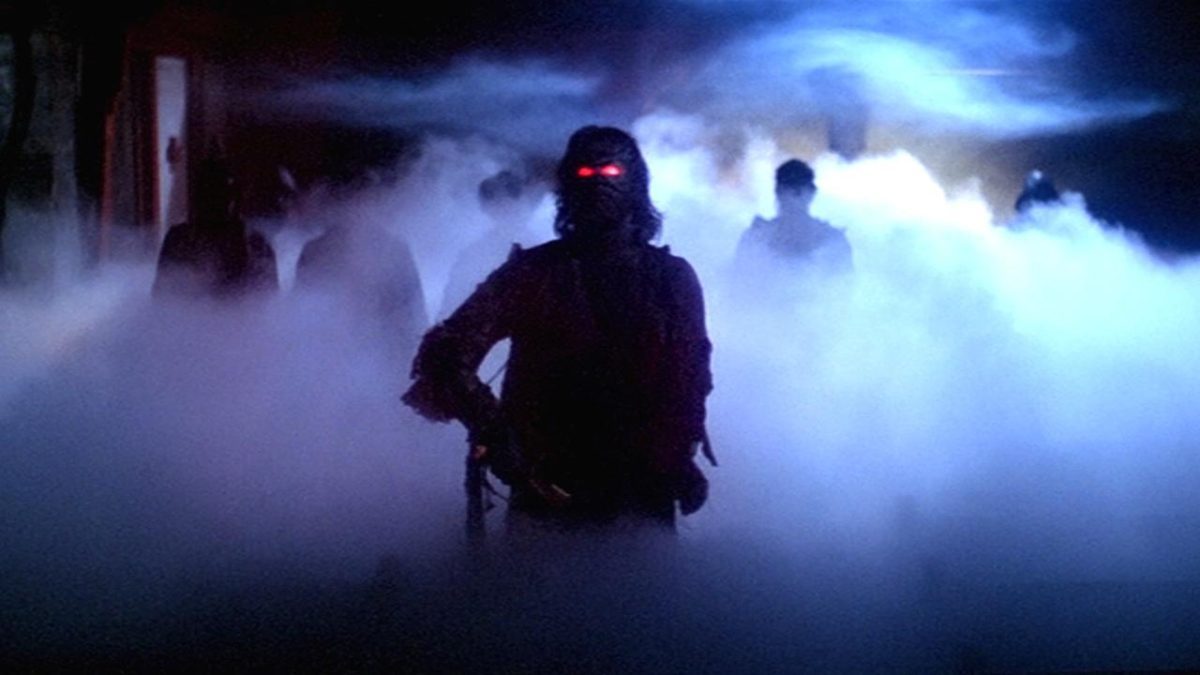
John Carpenter’s film career has had its critical ups and downs, but time – the final arbiter of success, perhaps – has been almost universally kind to the vast majority of his cinematic work.
Reviled upon release in the summer of Spielberg’s E.T., John Carpenter’s The Thing (1982) is now revered as a horror classic and a work of art superior to the Howard Hawks film of 1951.
Similarly, Carpenter’s anti-yuppie battle cry, They Live (1988) has been re-evaluated as an ahead-of-its time masterpiece about the imminent death of the middle class in America, and “vulture capitalists” picking at its bones.
Even In the Mouth of Madness (1994), dismissed on original release as lesser-Carpenter, is widely considered now to be the finest interpretation of the Lovecraft aesthetic yet committed to film.
Why do Carpenter’s films age so well, and thus almost universally merit serious re-examination?
In part this pattern repeats because his neo-classical visualizations — his understanding of where to place the camera for maximum visceral and artistic impact — compares so favorably to the modern green-screen “fix-it-in-post” approach to modern movie-making.
And in part this occurs because Carpenter’s work is admirably consistent. His canon features what might be readily termed an umbrella of unity. In particular, the director almost universally contextualizes his films as Westerns…only as westerns set in unusual settings such as Mars, or at the (supernatural) town of Hobb’s End.
The following five films — including Carpenter’s two most recent works — as yet await the full light of critical study and appreciation, but nonetheless deserve to be spotlighted. They are, as of right now, Carpenter’s most underrated works of art.
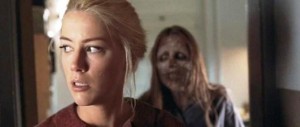
5. The Ward (2010)
Released at roughly the same time as Scorsese’s Shutter Island (2009), Carpenter’s film is a much more stream-lined – and blunt — narrative about roughly the same topic: one individual’s battle for sanity in an inhuman place, a sanitarium for the mentally ill.
The Ward focuses a young woman, Kristen (Amber Heard) who is incarcerated at North Bend Psychiatric Hospital in 1966 after setting fire to a farmhouse.
Kristen is remanded to a “ward” with other young woman whom society deems lost causes. The women of the ward are treated cruelly by Dr. Stringer’s (Jared Harris) staff but there is a darker menace to countenance as well: the angry spirit of a former patient, Alice Hudson…
The Ward features an unrelenting atmosphere of amorphous dread, a fear that something is wrong not only in the ward, but with reality itself.
Accordingly, Carpenter’s camera lingers obsessively on the details of this unpleasant purgatory, including an antiquated intercom system, on an old record player and a TV set playing scenes from the Bert I. Gordon movie, Tormented [1960]). But this acute sense of place is also strongly enhanced by Carpenter’s stalking camera, which is always heading down another (crumbling) corridor…but never finding an exit.
Audiences thus visually glean the notion that the North Bend Ward is a maze from which there is no escape. Possible portals to sanctuary, like an always-recalcitrant elevator or a rickety dumbwaiter in the basement, lead from one level — of Hell? — to another, but the world outside is itself a remote fantasy,. This notion is reinforced by the fact that the film features exteriors almost only in the prologue and epilogue.
By remaining largely in that confining, even claustrophobic labyrinth of the ward, Carpenter’s film erects a case about the suffering and abandonment of the mentally ill. They are locked away in fearsome places such as North Bend, and the film opens with unsettling images of the mistreatment of the mentally ill across the span of history.
In addition to these title images, Carpenter also utilizes a wide variety of editing techniques to suggest the fracturing of personal sanity, or consensus reality. He carves up the characters’ already crumbling sense of time and space with frequent dissolves and jump cuts. These visualizations appear to forge an artful comparison between the brevity of human life and the eternal, unchanging nature of North Bend.
Some viewers may not be totally satisfied with the resolution of Kristen’s story (though it is assiduously prepared for by both Carpenter’s direction and the details of the solid screenplay), but The Ward accomplishes what only the best horror films achieve: the thorough mining of a single location, and the dreadful impact of that place on the psyche.
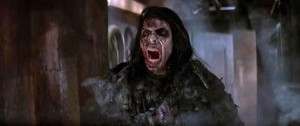
4. Ghosts of Mars (2001)
Arriving in theaters just weeks ahead of the traumatic events of 9/11 in 2001, Ghosts of Mars didn’t achieve much success at the box office, despite the fact that it was the latest and most ambitious entry in the director’s “siege” trilogy, which also includes Assault on Precinct 13 (1976), and Prince of Darkness (1987). All three films also reflect, in some fashion, the brothers-in-arm (or “bro-mance”) ethos of one of Carpenter’s favorite Hawks’ films: Rio Bravo (1959).
Set in the year 2176 AD, on the partially-terra-formed frontier planet Mars (ruled by “The Matronage” and a business conglomeration called “The Cartel”), a police officer, Ballard (Natasha Henstridge) and her squad attempt to apprehend a notorious criminal, Desolation Williams (Ice Cube) at a frontier town in the southern sector known as Shining Canyon.
What Ballard and her squad (including Jason Statham, Pam Grier and Clea Du Vall) find there, however, is an uprising of deadly Martian ghosts, released from a centuries-long slumber in an ancient tomb. With the ability to possess the livings, these Martian warriors are out to reclaim their planet, a fact which necessitates a team up between law-enforcers and law-breakers, and Ballard and Williams.
In an era when Hollywood was churning-out chop-suey-styled, quick-cut action sequences in dreadful films like Underworld (2003), John Carpenter was crafting coherent, suspenseful, tense and sustained action sequences like the ones featured in Ghosts of Mars.
In the film’s (gory) confrontations there is no doubt what is happening, or who it is happening to, and you can actually see the impressive stunts in their beautifully choreographed splendor. The results, when coupled with a score from Anthrax, are positively adrenalin-provoking.
More to the point, perhaps, Carpenter infuses his familiar “siege” scenario with two imaginative touches.
First, he features a future culture in which long-standing white male entitlement and domination is a thing of the past, an opportunity for some good, humorous touches about the never-ending war of the sexes.
And secondly, he recreates, in large part, the dynamic of the film Zulu (1974), which diagrammed the true story of a landmark 1879 battle at “Rorke’s Drift” in Africa. There, 150 British soldiers survived a siege by over 4,000 Zulu warriors at a supply depot and hospital.
The “ghosts” of Carpenter’s film evoke strong memories of the African attackers in Zulu. In both cases, the oncoming horde is visually differentiated from the forces of the establishment/imperialist/west in ways that make them appear both savage and alien. If you happen to look at Peter Jackson’s blockbuster, The Two Towers (2002), you can plainly detect how some of the same ideas and visuals featured in Zulu and Ghosts of Mars provided the foundation for the Helm’s Deep attack in that film.
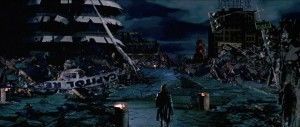
3. Escape from L.A. (1996)
In 1996, Escape from L.A. was a sequel to the beloved Escape from New York (1981) that nobody seemed to love, or even like very much.
The only sequel Carpenter has ever directed, the film showcases the maverick auteur, unexpectedly, in full-on satire mode.
To wit, Escape from L.A. imagines a near-future of religious right radicalism and “political correctness” in which atheists, Muslims, and other “sinners” are banished to Los Angeles Island by a U.S. President (Cliff Robertson) who resembles Jerry Falwell, and who has moved the White House to Lynchburg, Virginia.
Kurt Russell’s Snake Plissken returns for the sequel, this time to rescue the President’s daughter from a revolutionary in Los Angeles, and recover an EMP device called “The Sword of Damocles.”
Before long, however, the satirical elements of the story come to full flower, and Snake meets a band of plastic-surgery deformed freaks in Beverly Hills, led by Bruce Campbell, and launches an aerial assault on the equivalent of…Disneyland.
Escape from L.A. even satirizes its predecessor. In Escape from New York, Snake had to fight in a kind of quasi-gladiatorial game against a huge opponent, for the pleasure of the Duke of New York. Here, he is required to…shoot hoops. Snake must sink ten baskets in a row, or face execution, all while he has a bum leg.
A sweeping rejection of the radical right wing, the entertainment industry, and even the standards of action film-making, Escape from L.A. has never been fully parsed for what it so abundantly remains: Carpenter’s biggest-budgeted act of silver screen subversion, a giant upturned finger to every aspect of “the establishment.”
In a pure expression of Carpenter’s distaste for The System, Escape from L.A. even ends with Plissken bringing it all down, thus forwarding the notion that it is time to re-start the human race and build a more humane, more decent culture.
Today, the only Escape from L.A.’s CGI special effects have aged badly. Everything else about this Carpenter film seems more pointed and powerful than it did in 1996.

2. Big Trouble in Little China (1986)
A box office failure in 1986, Big Trouble in Little China is considered a cult-classic today, but it deserves to be remembered as much more than that “niche” description implies. This rip-roaring action film is actually high-water point for 1980s action cinema, and a sometimes caustic, sometimes optimistic East meets West culture clash.
Where Sylvester Stallone and others were playing heroes like Cobra or Rambo absolutely straight during the era, and offering comforting “do-we-get-to-win-this-time” bromides about American military might and the defeat in Vietnam, Carpenter’s film instead highlighted hero Jack Burton (Kurt Russell), a blundering, swaggering truck driver unexpectedly caught up in the world of Chinese gangs, and more dangerously, Chinese legends about the supernatural.
It was actually Jack’s sidekick, Wang Chi (Dennis Dun) who was the real hero of the film, both true of heart and skilled in combat. So Big Trouble in Little China not only corkscrewed the typical hero-sidekick dynamic of Hollywood — in which the American was always the main good guy — it set up a dramatic debate about Eastern virtues and Western virtues.
In Time Magazine at the time, Richard Corliss termed Big Trouble in Little China a “master’s thesis that moves,” and perhaps there is no better description of this frenetic, funny, Western introduction to the Chinese form of wu-xia, the Eastern equivalent of Joseph Campbell’s mono-myth or “heroic journey” epic.
As a so-called “thesis that moves,” it might behoove modern filmmakers to study up on this surprising, always-in-motion, brilliantly-choreographed film.
Big Trouble in Little China has, today, lost none of its humorous punch, and the film’s elaborate fight scenes — including one featuring sixty combatants — remain some of the best ever committed to film
.
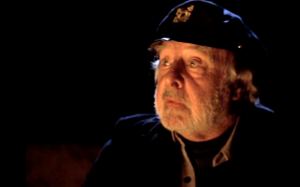
1. The Fog (1980)
Carpenter’s follow-up to Halloween (1978) has never quite achieved the critical approbation that the spooky ghost story so abundantly deserves. In short, the film is about, in very striking terms, the way that stories shape and sometimes re-shape historical fact.
In The Fog, the seaside town of Antonio Bay prepares to celebrate its one-hundredth anniversary. But on this momentous occasion, murderous ghosts from the past appear to reveal to the town’s denizens that their “founding fathers” built the town not on boot-strap-ism and hard work, but upon murder and theft.
Specifically, six founding fathers or co-conspirators stole gold belonging to a rich Leper, Blake, when they sunk his ship, the Elizabeth Dane, on a foggy April night.
Now, the sins of the fathers must be paid by the children as the water-logged spirits of the dead attack the town, looking to reclaim their stolen treasure.
The first scene in The Fog remains one of the absolute best in the Carpenter canon. It takes place around a camp-fire, on the beach, near midnight, as old Mr. Machen (John Houseman) recites an old ghost story to several frightened children, including young Andy (Ty Mitchell), the son of D.J. Stevie Wayne (Adrienne Barbeau).
Machen’s story about the sinking of the Elizabeth Dane is riveting, but it also explores the way that, across the generations, we create, alter and continue our mythology. By the film’s end, it is Stevie herself — broadcasting on the radio — who conveys the next “chapter” in this myth, and carries the tradition forward.
From a camp-fire story to a radio broadcast, the film cleverly explains how the oral tradition of storytelling survives and endures. More to the point, perhaps, there’s a subplot in The Fog about the ways that people bury the truth (sometimes even in the “walls” of a church…) and create more palatable ones for public consumption.
As Hal Holbrook’s Father Malone explains to a town elder (Janet Leigh), their celebration of the founding-fathers is actually one “honoring murderers.” On a broad scale, then, this horror film sub-textually explores the idea that America’s twentieth century wealth is built not on decades of freedom and opportunity, as we mythologize, but upon less noble principles. The film concerns the seamy underside, of the American dream exactly at the point in history that the same myth was “renewing” itself, at the beginning of the Reagan Revolution.
Bolstered by beautiful location photography, The Fog is a literate, meaningful ghost story with a central threat of a remarkable visual nature. The fog itself seems to be alive, constantly re-shaping itself, constantly weaving itself into new venues. The menace could thus be contextualized as an avatar for the truth attempting to get a hold on the modern conscience.
More than any other Carpenter film, perhaps, The Fog deserves to be added to the pantheon of great — and classic — horror movies of the late 20th century.
Would you like to support Flashbak?
Please consider making a donation to our site. We don't want to rely on ads to bring you the best of visual culture. You can also support us by signing up to our Mailing List. And you can also follow us on Facebook, Instagram and Twitter. For great art and culture delivered to your door, visit our shop.


